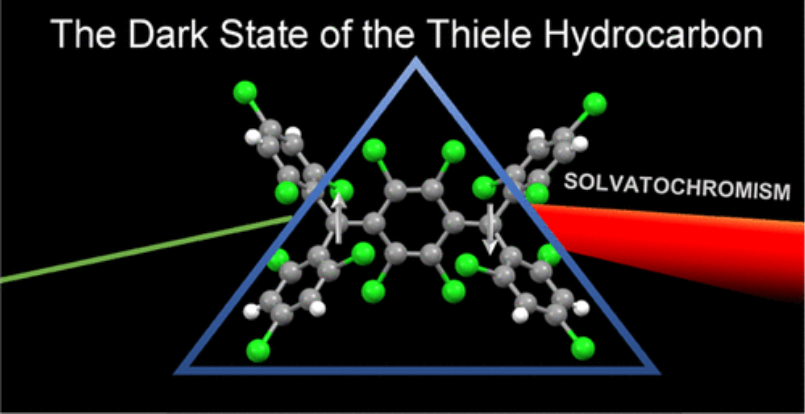Punzi, A., Dai, Y., Dibenedetto, C. N., Mesto, E., Schingaro, E., Ullrich, T., Striccoli, M., Guldi, D. M., Negri, F., Farinola, G. M., Blasi, D., Journal of the American Chemical Society 2023, 145, 20229-20241. 10.1021/jacs.3c05251
In this work, a comprehensive investigation of the photoinduced processes and mechanisms linked to the luminescence of a novel nonperchlorinated Thiele hydrocarbon (TTH) is presented. Despite the comparable diradical character of TTH (y0 = 0.32–0.44) and the unsubstituted Thiele hydrocarbon (TH) (y0 = 0.30), the polyhalogenated species is inert and photostable, showing an intense deep-red/near-infrared (NIR) fluorescence (photoluminescence quantum yield (PLQY) = 0.84 in toluene) even at room temperature and in the solid state (PLQY = 0.19). TTH displays a large Stokes shift (307 nm in benzonitrile) and solvatochromic behavior, which is unusual for a centrosymmetric, nonpolar, and low-conjugated species. These outstanding emission features are interpreted through quantum-chemical calculations, indicating that its fluorescence arises from the low-lying dark doubly excited zwitterionic state, typically found at low excitation energies in diradicaloids, acquiring dipole moment and intensity by state mixing via twisting around the strongly elongated exocyclic CC bonds of the excited p-quinodimethane (pQDM) core, with a mechanism similar to sudden polarization occurring in olefins. Such a mechanism is derived from ns and fs transient absorption measurements.

Punzi, A., Dai, Y., Dibenedetto, C. N., Mesto, E., Schingaro, E., Ullrich, T., Striccoli, M., Guldi, D. M., Negri, F., Farinola, G. M., Blasi, D., Journal of the American Chemical Society 2023, 145, 20229-20241. 10.1021/jacs.3c05251
In this work, a comprehensive investigation of the photoinduced processes and mechanisms linked to the luminescence of a novel nonperchlorinated Thiele hydrocarbon (TTH) is presented. Despite the comparable diradical character of TTH (y0 = 0.32–0.44) and the unsubstituted Thiele hydrocarbon (TH) (y0 = 0.30), the polyhalogenated species is inert and photostable, showing an intense deep-red/near-infrared (NIR) fluorescence (photoluminescence quantum yield (PLQY) = 0.84 in toluene) even at room temperature and in the solid state (PLQY = 0.19). TTH displays a large Stokes shift (307 nm in benzonitrile) and solvatochromic behavior, which is unusual for a centrosymmetric, nonpolar, and low-conjugated species. These outstanding emission features are interpreted through quantum-chemical calculations, indicating that its fluorescence arises from the low-lying dark doubly excited zwitterionic state, typically found at low excitation energies in diradicaloids, acquiring dipole moment and intensity by state mixing via twisting around the strongly elongated exocyclic CC bonds of the excited p-quinodimethane (pQDM) core, with a mechanism similar to sudden polarization occurring in olefins. Such a mechanism is derived from ns and fs transient absorption measurements.